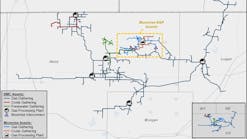Parnell announces Point Thomson agreement, pipeline commitment
Two major milestones were met in Alaska’s efforts to bring North Slope natural gas to Alaskans and markets beyond, Gov. Sean Parnell announced. The state has resolved its long-running litigation with ExxonMobil Corp. and other Point Thomson field leaseholders, he told reporters in Anchorage.
He also has received a letter from BP PLC, ConocoPhillips, and ExxonMobil’s chief executives stating that they are aligned with the Alaska Pipeline Project sponsors and are working on a major pipeline project to move gas from the North Slope to a possible liquefied natural gas export terminal in South-Central Alaska, Parnell said.
“This is historically significant. Nobody in this building or the state has ever seen anything like this,” he maintained. “The parties are working to finalize commercializing of their gas project, including development of pipelines to distribute some of the gas in Alaska.”
The settlement between the state and leaseholders ExxonMobil, BP, ConocoPhillips, Chevron, and Leede ends a 7-year battle over Alaska’s largest undeveloped gas field. It requires the producers to begin producing gas liquids by the winter of 2015-16 from the field and build a 70,000 b/d common carrier pipeline connecting to the Trans-Alaska Pipeline System.
“It is settled around one critical principle: The companies must earn their acreage,” Natural Resources Commissioner Daniel S. Sullivan explained. “The more work, more commitments, more investments, and more production that occur, the more Point Thomson acreage the companies will retain.”
Main provisions
He said if the companies do not begin liquids production by the winter of 2015-16, significant amounts of acreage will automatically return to the state. Beyond near-term liquids production, if the companies do not commit to or sanction a full-field development alterative for Point Thomson, they will lose significant acreage, Sullivan said.
The settlement provides incentives to commercialize the North Slope’s vast gas resources by helping to position Point Thomson for gas development, facilitating alignment of interests between the major North Slope producers and the state, and installing critical infrastructure for gas sales, he indicated. It also provides potential for significant in-state gas sales by 2019 and requires a commitment to develop a separate crude oil reservoir within Point Thomson.
Sullivan said the companies have agreed to firm Point Thomson production timetables which will result in significant new investment, more work for Alaskans, and increased revenue for the state and local governments. “This field is so significant and litigation has gone on so long that there are certain provisions we wouldn’t have considered otherwise,” he observed.
In their letter to Parnell, Chief Executives Rex W. Tillerson of ExxonMobil, James J. Mulva of ConocoPhillips, and Robert Dudley of BP said that while Alaska’s North Slope holds more than 35 tcf of gas, it has mostly been used so far to enhance crude oil production, adding several billion barrels to Kuparuk and Prudhoe Bay field recoveries.
“Serious discussions between our companies have taken place over the past several months, along with the Alaska Pipeline Project (APP) parties who are supporting the [Alaska Gasline Inducement Act] license,” they continued. “We have aligned on a structured, stewardable, and transparent approach with the aim to commercialize North Slope natural gas resources within an AGIA framework.”
Considering LNG exports
They said because of a rapidly evolving global market, large-scale LNG exports from South-Central Alaska will be considered as an alternative to a gas pipeline through Alberta. “In addition to broadening market access, a South-Central Alaska LNG approach could more closely align with in-state energy demand and needs,” the executives said.
“We are now working on the gas commercialization concept selection, which would include an associated timeline and an assessment of major project components including in-state pipelines routes and capacities, global LNG trends, and LNG tidewater site locations, among others,” they told Parnell.
Sullivan said no matter which gas pipeline crosses Alaska, much of the federal regulatory work has been done already. Filings last month envisioned a dual capacity system, he said during the press conference. “Work that has been done to export the gas to Alberta can be used to support LNG exports,” he noted.
Responding to a question about competing projects to serve LNG customers in Asia, the Alaskan official observed: “What we have seen from customers who are looking to diversify their sources is an interest in Alaska gas that provides many comparative advantages that other supplies to Asia don’t have.”
In a separate joint release, ExxonMobil, ConocoPhillips, and BP said that they support meaningful Alaska tax reform such as legislation introduced by Parnell which will encourage increased investment and establish an economic foundation for further commercializing North Slope resources.
“Commercializing Alaska natural gas resources will not be easy,” the chief executives said in their letter to Parnell. “There are many challenges and issues that must be resolved, and we cannot do it alone. Unprecedented commitments of capital for gas development will require competitive and stable fiscal terms with the State of Alaska first be established.”
Contact Nick Snow at [email protected].

Nick Snow
NICK SNOW covered oil and gas in Washington for more than 30 years. He worked in several capacities for The Oil Daily and was founding editor of Petroleum Finance Week before joining OGJ as its Washington correspondent in September 2005 and becoming its full-time Washington editor in October 2007. He retired from OGJ in January 2020.

